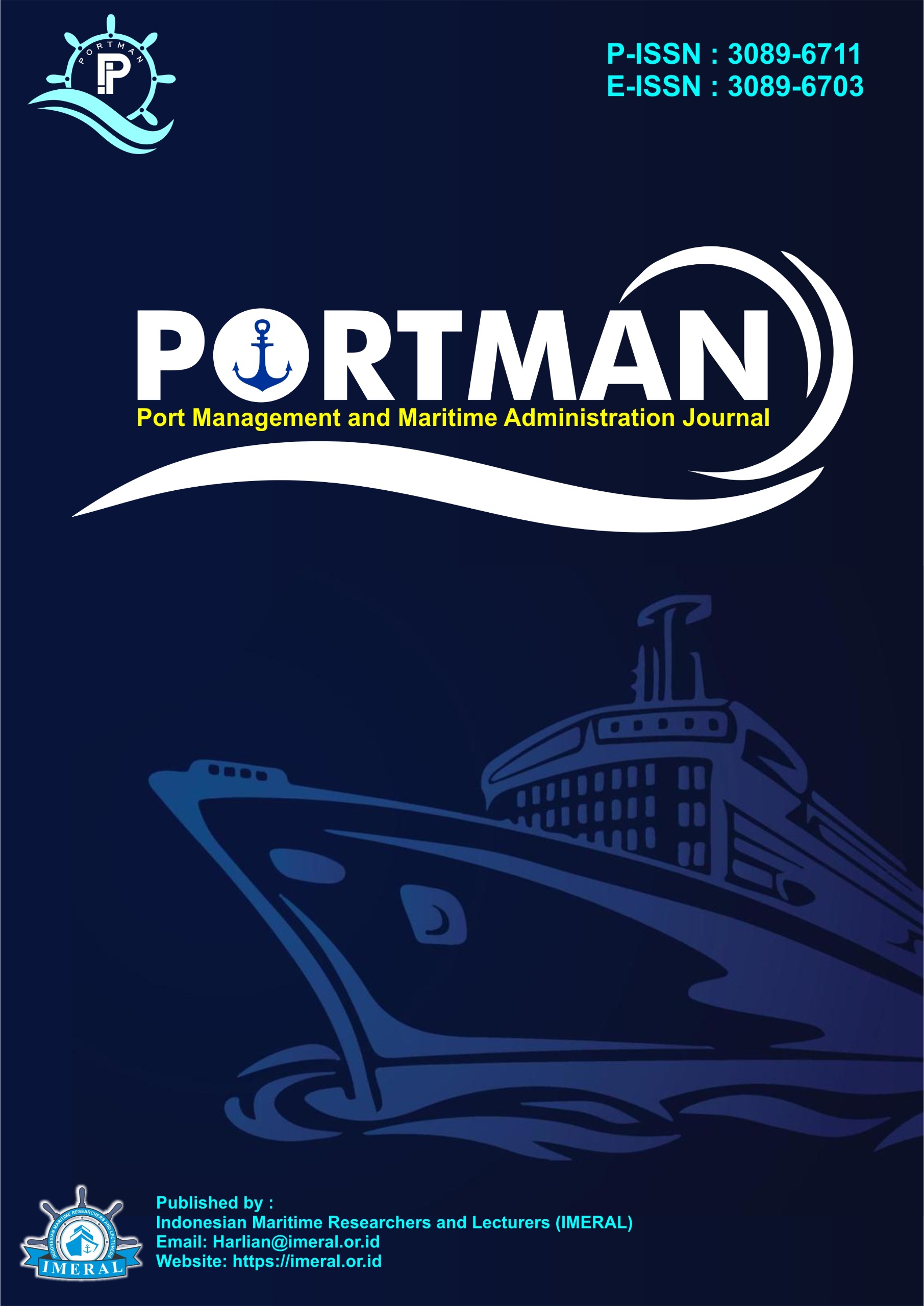Pengaruh Perubahan Iklim terhadap Eksploitasi Sumber Daya di Luar Zona Ekonomi Eksklusif (ZEE) di Kawasan Arktik dalam Perspektif Maritime Security
DOI:
https://doi.org/10.65428/portman.v1i2.16Keywords:
Arctic Region, Climate Change, Exclusive Economic Zone, Resource Exploitation, Maritime SecurityAbstract
The Arctic region has abundant natural resource potential, which has encouraged Arctic coastal countries to explore and exploit existing resources. However, the presence of climate change has changed territorial boundaries including the Exclusive Economic Zone (EEZ) and opened up effective routes in the Arctic. Therefore, this study discusses climate change on the exploitation of resources outside the Exclusive Economic Zone by each country in the Arctic region and the impact of such exploitation on the maritime security of the Arctic sea. The approach used is qualitative-descriptive with a literature study method. The data used are secondary data obtained from books, journal articles, and relevant and trusted websites. The theories used in this study are climate change/climate change and maritime security/maritime security. The results of this study indicate that there is an influence of climate change on the opening of access and rising sea levels in the Arctic which results in uncertain territorial sea boundaries. Thus encouraging exploitation in the Arctic region which has implications for maritime security.
References
Aquavis. (2025). Pop: The Arctic & its rising importance: An exploration of the Arctic and its role in the evolving global order. https://aquavis.substack.com/p/pop-the-arctic-and-its-rising-importance
Arctic Council. (2025). The Arctic in a changing climate. https://arctic-council.org/explore/topics/climate/
Arctic Portal. (2025). The Arctic. https://arcticportal.org/the-arctic-portlet/hot-topics/natural-resources
Boyd, R., et al. (2016). Mineral resources in the Arctic. Geological Survey of Norway.
Brosnan, I. G., Lechine, T. M., & Miles, E. (2011). Cooperation or conflict in a changing Arctic. Ocean Development & International Law, 42, 172–210. https://doi.org/10.1080/00908320.2011.561957
Bueger, C. (2015). What is maritime security? Marine Policy, 53, 159–164. https://doi.org/10.1016/j.marpol.2014.12.005
Dewi, A. R., & Rosalina, E. (n.d.). Mengenal perubahan iklim. Indonesia Research Institute for Decarbonization.
Dodds, K., & Nuttall, M. (2019). The Arctic: What everyone needs to know. Oxford University Press.
Donesia, et al. (2023). Konsep blue economy dalam pengembangan wilayah pesisir dan wisata bahari di Indonesia. Jurnal Kewarganegaraan, 7(2), 1950–1959.
European Commission. (n.d.). Causes of climate change. https://climate.ec.europa.eu/climate-change/causes-climate-change_en
Evans, J., & Osthagen, A. (2021). Fisheries disputes: The real potential for Arctic conflict. https://www.thearcticinstitute.org/fisheries-disputes-real-potential-arctic-conflict/
Frebrianti, N. (2018). Hubungan pemanasan global dengan kondisi suhu udara dan curah hujan di Indonesia. Research Gate, 299–305.
Gavrilov, V., Dremliuga, R., & Nurimbetov, R. (2019). Article 234 of the 1982 United Nations Convention on the Law of the Sea and reduction of ice cover in the Arctic Ocean. Marine Policy, 104, 1–6. https://doi.org/10.1016/j.marpol.2019.02.049
Graff, J. (2007). Arctic: Fight for the top of the world. https://time.com/archive/6682208/arctic-fight-for-the-top-of-the-world/
International Maritime Organization. (n.d.). International code for ships operating in polar water (Polar Code). https://www.imo.org/en/ourwork/safety/pages/polar-code.aspx
IPCC. (2021, August 9). Climate change widespread, rapid, and intensifying. https://www.ipcc.ch/2021/08/09/ar6-wg1-20210809-pr/
Karlina, W. R., & Viana, A. S. (2020). Pengaruh naiknya permukaan air laut terhadap perubahan garis pangkal pantai akibat perubahan iklim. Jurnal Komunikasi Hukum, 6(2), 575–586.
Miller, E. E. (2019). Empire of ice: Arctic natural history and British visions of the North 1500–1800 (Doctoral dissertation, University of Minnesota).
Ministry of Environment and Forestry Republic of Indonesia. (2018). Mengukur dan reduksi gas rumah kaca. http://perpustakaan.menlhk.go.id/pustaka/home/index.php?page=detail_news&newsid=474
Narwati, E., et al. (2022). Dampak pergeseran wilayah akibat naiknya permukaan laut dan dampaknya bagi navigasi. Media Luris, 5(1), 41–66.
National Environment Commission. (2011). Climate change. Thimphu: National Environment Commission.
Parlemen UK. (2023). Prospek dan dampak meningkatnya aktivitas ekonomi di kawasan Arktik. https://publications.parliament.uk/pa/ld5804/ldselect/ldintrel/8/808.htm
Probotrianto, A. F. (2021). Masyarakat adat dan diskursus representasi di lingkar Arktik: Tinjauan kosmopolitanisme dan geopolitik krisis. Jurnal Hubungan Internasional, 1, 63–60.
Resource Development Council. (n.d.). Alaska’s mining industry. https://www.akrdc.org/mining
Sakib, S. M. N. (2022). Assessing the impact of Arctic melting in the predominantly multilateral world system. Asia Pacific Journal of Environment and Cancer, 5(1), 25–43.
Shible, M. A., & Rashid, M. M. (2021). Geopolitics of the Arctic: Through the lens of state securitization. Journal of Global Politics and Current Diplomacy, 9(1), 52–62.
Simon-Ekeland, A. (2023). Dreams of Arctic flight: French aerial polar expedition projects. Modern Geografia, 18(1), 135–154.
United Nations. (n.d.). Convention on the Law of the Sea.
US EPA. (2024). Basics of climate change. https://www.epa.gov/climatechange-science/basics-climate-change
US Geological Survey. (2008). Circum-Arctic resource appraisal: Estimates of undiscovered oil and gas north of the Arctic Circle.
Vienna Convention on the Law of Treaties. (1969). Vienna Convention on the Law of Treaties done at Vienna on 23 May 1969.
Viktoria, N. (2023). The Arctic from a Hungarian perspective. Modern Geografia, 18(1), 41–57.
Wiliyanto, W., et al. (2024). No man’s land longer: Kontestasi sumber daya dan geopolitik di kawasan Arktik. Institute of International Studies, Universitas Gadjah Mada.
Yaraghi, N., et al. (2020). Impact of gold mine effluent on water quality in a pristine sub-Arctic river. Journal of Hydrology, 589, 125185. https://www.sciencedirect.com/science/article/abs/pii/S0022169420306302?via%3Dihub





